Pallid Harrier Bird Details
Circus macrourus
Pallid Harrier,Eastern Marsh Harrier, Pale Harrier;
Cheer-Hari, Pila Girgitmaar
Gmelin, 1770
Accipitriformes (HAWKS, EAGLES and KITES)
Accipitridae
Circus
- Breeding Range: Eastern Europe (Romania, Hungary), Central Asia (Kazakhstan, southern Russia).
- Wintering Range: India, Pakistan, parts of Africa (Ethiopia, Kenya, Tanzania), and Southeast Asia.
Appearance :
Male has Pale greyish-white with black wingtips and yellowish eyes. The male has a distinctive slender body and long wings. Female has brownish with streaks and a barred tail. They appear more robust and have brownish eyes. Both sexes have long legs and a distinct facial disc similar to owls, aiding in sound localization when hunting.
Behaviour :
They are solitary birds but may form small groups during migration. Flight is characterized by low, smooth, and gliding patterns, often over open ground. Harriers are ground-nesters and are known to be agile hunters, using their long wings and tail for maneuverability.
Habitat :
Open landscapes, grasslands, steppe, and agricultural fields. They prefer low vegetation areas, avoiding dense forests and high mountains. They are ground-nesting raptors.
Diet :
Primarily feeds on small mammals (rodents), birds, reptiles, and large insects. Their hunting style is low flight over fields or grasslands, detecting prey with sharp vision and hearing.
Conservation Status :
Near Threatened
Distribution :
Breeds in southern Europe, Central Asia, and parts of Russia. Migrates to winter in Africa, India, and Southeast Asia.
Population Size :
Estimated population between 15,000 to 50,000 individuals globally.
Life Span :
Average life span is between 10 to 15 years in the wild.
Body And Tarsus:
- Body: Slender, long-winged and long-tailed hawk with a somewhat graceful appearance.
- Tarsus Length: Approximately 7.5 to 9 cm.
Head And Bill :
- Head: Small and rounded with a relatively flat crown.
- Bill: Slightly curved, suitable for capturing small prey.
- Bill Length: About 2.5 to 3.5 cm.
Length :
Approximately 40 to 50 cm.
Neck :
Long and slender, contributing to its agile flying ability.
Size :
Males are typically smaller than females, with noticeable sexual dimorphism in size and coloration.
Tail Details :
- Tail: Long and graduated with a distinctive pattern.
- Tail Length: About 15 to 20 cm.
- Feathers: The plumage is generally pale with darker markings.
Weight :
Males typically weigh around 200 to 300 grams, while females can weigh between 300 to 500 grams.
Wing :
Long and pointed wings, aiding in soaring and agile flight.
Wing Span :
Approximately 110 to 130 cm.
Facial Feature :
The Pallid Harrier has a distinctive pale face with a dark crown and prominent facial markings.
Nest Details :
- Nest: Nests are usually placed on the ground in dense vegetation, often in wetlands or grasslands.
- Nest Made Up Of: Primarily constructed from grass, reeds, and other vegetation.
Breeding Season :
Typically from April to August, varying by region.
Nesting Season :
Generally coincides with the breeding period; usually begins in late April or early May.
Egg Color :
Usually pale blue or greenish with brown or olive spots.
Egg Length :
Approximately 43-50 mm.
Egg Width and Weight :
Clutch Size :
Typically consists of 3 to 6 eggs.
No. of Broods :
Usually one brood per breeding season.
Incubation Period :
Around 30-32 days.
Nestling Period :
Typically 30-40 days until fledging.
Vocalization :
Known for a range of calls, including sharp, high-pitched notes during breeding displays and softer calls for communication.
Sex Demorphism :
Males are generally lighter and more uniformly gray, while females are larger, with a brown plumage and a more streaked appearance.
Migration Details :



